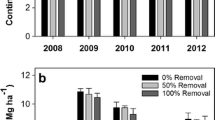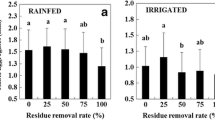Abstract
Corn (Zea mays L.) stover was identified as a renewable non-food agricultural feedstock for production of liquid fuels, biopower, and other bioproducts, but it is also needed for erosion control, carbon sequestration, and nutrient cycling. To help balance these multiple demands, our objectives were to (1) determine height distribution of corn stover biomass, (2) quantify the percentage of stover that is corn cob, and (3) develop a general relationship between plant harvest height and stover remaining in the field for a broad range of growing conditions, soil types, and hybrids in different regions. Plant height, dry grain, stover, and cob yield data were collected at eight US locations. Overall, stover yield increased about 0.85 Mg ha-1 and cob yield increased about 0.10 Mg ha-1 for each 1.0 Mg ha-1 increase in dry grain yield. At grain harvest, the stover-to-grain ratio ranged from 0.64 to 0.96 and cob-to-grain ratio ranged from 0.11 to 0.19. A strong nearly 1:1 linear (r 2 = 0.93) relationship between the relative cutting height and relative biomass remaining in the field was observed across all sites. These data were requested by the US Department of Agriculture-Natural Resource Conservation Service to help improve version 2 of the Revised Universal Soil Loss Equation (RUSLE2) and Wind Erosion Prediction System and better estimate corn stover harvest rates based on cutting height or selective organ harvest (e.g., grain and cob only). This information will improve the capacity of RUSLE2 and similar models to predict the erosion risk associated with harvesting corn residues.







Similar content being viewed by others
Abbreviations
- (GLM):
-
General linear model
- (HI):
-
Harvest index
- (RUSLE2):
-
Revised Universal Soil Loss Equation version 2
- (SOM):
-
Soil organic matter
- (USDA-ARS):
-
US Department of Agriculture-Agriculture Research Service
- (USDA-NRCS):
-
US Department of Agriculture-Natural Resource Conservation Service
- (WEPS):
-
Wind Erosion Prediction System
References
Allmaras RR, Gupta SC, Pikul JLJ, Johnson CE (1979) Tillage and plant residue management for water erosion control on agricultural land in eastern Oregon. J Soil Water Cons 34:85–90
Aristos A, Schechinger T, Birrell SJ, Euken J (2007) Collection, commercial processing, and utilization of corn stover. Final technical report. DOE Scientific and Technical Information. Available at: http://www.osti.gov/bridge/product.biblio.jsp?osti_id=917000. Accessed 29 January 2010
Bilbro JD, Fryrear DW (1994) Wind erosion losses as related to plant silhouette and soil cover. Agron J 86:550–553
Biomass Research and Development Board (2008) Increasing feedstock production for biofuels: Economic drivers, environmental implications, and the role of research. Biomass Research and Development Board. Available at: http://www.brdisolutions.com/Site%20Docs/Increasing%20Feedstock_revised.pdf. Accessed 8 December 2008
Campbell RB, Matheny TA, Hunt PG, Gupta SC (1979) Crop residue requirements for water erosion control in six southern states. J Soil Water Cons 34:83–85
Chepil WS (1944) Utilization of crop residues for wind erosion control. Sci Agric 24:307–319
Cogo NP, Moldenhauer WC, Foster GR (1982) Soil loss reductions from conservation tillage practices. Soil Sci Soc Am J 48:368–373
Donald CM, Hamblin J (1976) The biological yield and harvest index of cereals as an agronomic and plant breeding criteria. Adv Agron 28:361–405
Fronning BE, Thelen KD, Min DH (2008) Use of manure, compost, and cover crops to supplant crop residue carbon in corn stover removed cropping systems. Agron J 100:1703–1710
Graham RL, Nelson R, Sheehan J, Perlack RD, Wright LL (2007) Current and potential US corn stover supplies. Agron J 99:1–11
Halvorson AD, Johnson JMF (2009) Corn cob characteristics in irrigated central Great Plains studies. Agron J 101:390–399
Hoskinson RL, Karlen DL, Birrell SJ, Radtke CW, Wilhelm WW (2007) Engineering, nutrient removal, and feedstock conversion evaluations of four corn stover harvest scenarios. Biomass Bioe 31:126–136
Igathinathane C, Womac AR, Sokhansanj S, Pordesimo LO (2006) Mass and moisture distribution in aboveground components of standing corn plants. Trans ASABE 49:97–106
Johnson JMF, Allmaras RR, Reicosky DC (2006) Estimating source carbon from crop residues, roots and rhizodeposits using the national grain-yield database. Agron J 98:622–636
Johnson JMF, Coleman MD, Gesch RW, Jaradat AA, Mitchell R, Reicosky DC et al (2007) Biomass-bioenergy crops in the United States: a changing paradigm. The Amer J Plant Sci Biotechnol 1:1–28
Johnson JMF, Papiernik SK, Mikha MM, Spokas K, Tomer MD, Weyers SL (2009) Soil processes and residue harvest management. In: Lal R, Steward B (eds) Carbon management, fuels, and soil quality. Taylor and Francis, LLC, New York, pp 1–44
Johnson JMF, Sharratt BS, Reicosky DC, Lindstrom MJ (2007) Impact of high lignin fermentation by-product on soils with contrasting soil organic carbon. Soil Sci Soc Am J 71:1151–1159
Laird DA (2008) The charcoal vision: a win–win–win scenario for simultaneously producing bioenergy, permanently sequestering carbon, while improving soil and water quality. Agron J 100:178–181
Lindstrom MJ (1986) Effects of residue harvesting on water runoff, soil erosion and nutrient loss. Agric Ecosys Environ 16:103–112
Lorenz AJ, Gustafson TJ, Coors JG, Nd L (2009) Breeding maize for a bioeconomy: a literature survey examining harvest index and stover yield and their relationship to grain yield. Crop Sci 50:1–12
Novak JM, Busscher WJ, Laird DA, Ahmedna M, Watts DW, Niandou AS (2009) Impact of biochar amendment on fertility of a southeastern coastal plain soil. Soil Sci 174:105–112
Pordesimo LO, Edens WC, Sokhansanj S (2004) Distribution of aboveground biomass in corn stover. Biomass Bioe 26:337–343
SAS (2002) SAS Version 9.1. SAS Institute Inc, Gary, NC,
Shinners KJ, Binversie BN (2007) Fractional yield and moisture of corn stover biomass produced in the Northern US Corn Belt. Biomass Bioe 31:576–584
Shinners KJ, Binversie BN, Muck RE, Weimer PJ (2007) Comparison of wet and dry corn stover harvest and storage. Biomass Bioe 31:211–221
Shinners KJ, Boettcher GC, Hoffman DS, Munk JT, Muck RE, Weimer PJ (2009) Single-pass harvest of corn grain and stover: performance of three harvester configurations. Trans ASABE 52:51–60
Siemens JC, Oschwald WR (1978) Corn-soybean tillage systems: erosion control, effects on crop production, costs. Trans ASAE 21:293–302
Skidmore EL (1988) Wind erosion. In: Lal R (ed) Soil erosion research methods. Soil Water Conserv Soc, Ankeny, pp 203–233
USDA-ARS (2008) Revised Universal Soil Loss Equation Version 2 (RUSLE2). DRAFT. In Washington, DC. Available at: http://www.ars.usda.gov/sp2UserFiles/Place/64080510/RUSLE/RUSLE64080512_Science_Doc.pdf. Accessed 21 July 2009
USDA National Agricultural Statistic Service (2006) Quick stats data base. Available at: http://www.nass.usda.gov. Accessed 9 June 2010
Wilhelm WW, Johnson JMF, Hatfield JL, Voorhees WB, Linden DR (2004) Crop and soil productivity response to corn residue removal: a literature review. Agron J 96:1–17
Wilhelm WW, Johnson JMF, Karlen DL, Lightle DT (2007) Corn stover to sustain soil organic carbon further constrains biomass supply. Agron J 99:1665–1667
Acknowledgements
The authors dedicate this publication to Dr. Wally Wilhelm for his foresight and dedication to protecting the soil resource while building a bioeconomy. He is sorely missed. We would like to thank Dr. Charles C. Mitchell (Dept. of Agronomy and Soils, Auburn University, AL) for allowing us to collect samples at The Old Rotation historic cotton research site. We also thank B. Burmeister for proof-reading the final version, but we take full responsibility for any errors. Publication costs were covered by funding from the North Central Regional Sun Grant Center at South Dakota State University through a grant provided by the US Department of Energy Office of Biomass Programs under award number DE-FC36-05GO85041.
Author information
Authors and Affiliations
Corresponding author
Additional information
The author Wally W. Wilhelm is deceased.
The US Department of Agriculture offers its programs to all eligible persons regardless of race, color, age, sex, or national origin, and is an equal-opportunity employer.
The use of trade, firm, or corporation names in this publication is for the information and convenience of the reader. Such use does not constitute an official endorsement or approval by the United States Department of Agriculture or the Agricultural Research Service of any product or service to the exclusion of others that may be suitable.
Rights and permissions
About this article
Cite this article
Wilhelm, W.W., Johnson, J.M.F., Lightle, D.T. et al. Vertical Distribution of Corn Stover Dry Mass Grown at Several US Locations. Bioenerg. Res. 4, 11–21 (2011). https://doi.org/10.1007/s12155-010-9097-z
Published:
Issue Date:
DOI: https://doi.org/10.1007/s12155-010-9097-z




